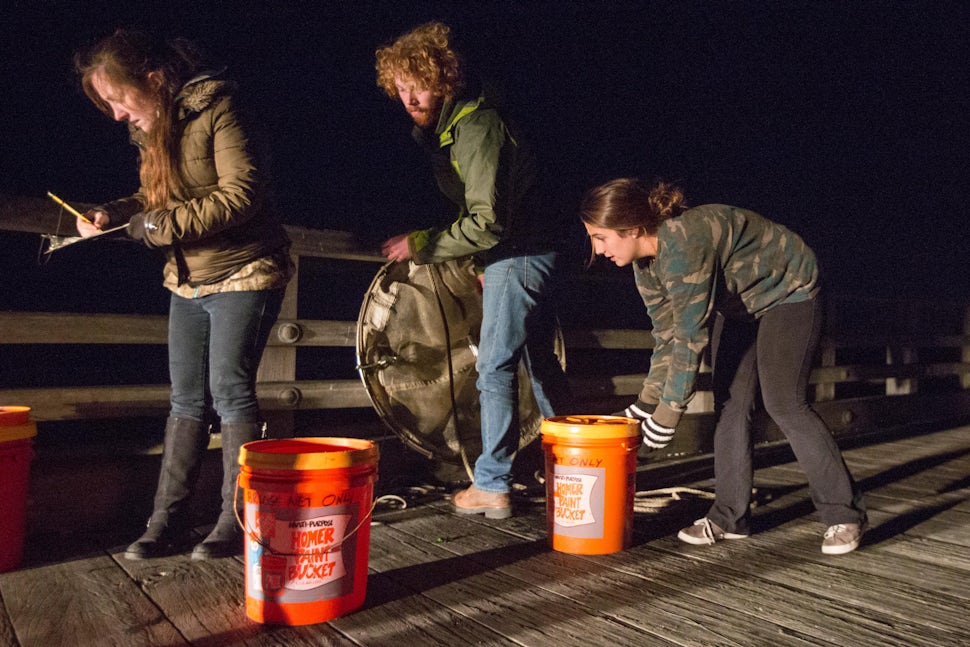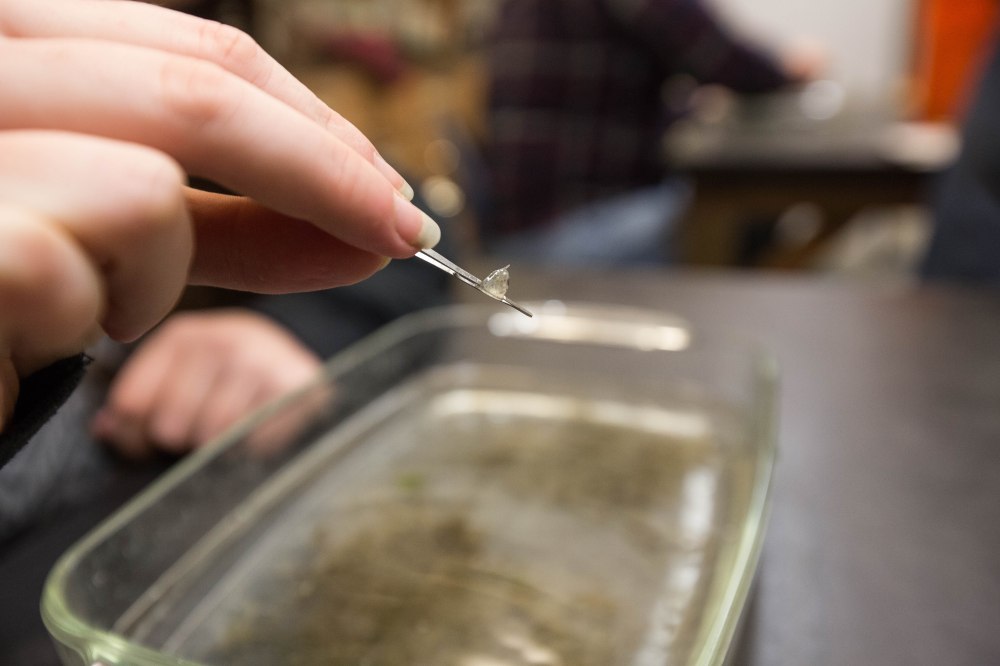Bridging Gaps to Understand Larval Fish Patterns on Great Bay
Former Coast Guard Lifesaving Station is a Research Hub in the Saltmarsh

Seven bridges along a seven-mile stretch of Great Bay Boulevard—prime bird watching and sunset viewing territory—lead to a former Coast Guard lifeboat station, now the Rutgers University Marine Field Station (RUMFS).
The soft pink swirls left over from sunset slowly fade to darkness, as the moon, one day past its supermoon phase, awakens to rise through light cloud cover. At the end of a long wooden boardwalk stilted on telephone poles, the three-story research hub stands stoic under a red roof in a vast expanse of undeveloped saltmarsh. A great blue heron flying overhead breaks the silence with a grumpy squawk.
As the workday ends, Roland Hagan, a staff researcher, and Joe, a seasonal marine field technician, prepare for the volunteers who will soon be arriving to participate in icthyoplankton bridge netting.
 Tying a knot to secure the icthyoplankton net.
Tying a knot to secure the icthyoplankton net.
Larval fish, known as icthyoplankton by scientists, aren’t developed enough to swim with fins, so they use their air bladders to move up and down the water column. During daylight, they lay low in the depths, avoiding predators. When the sun goes in, the larvae float up. They can climb vertically on their own and drift horizontally with the currents in search of nourishment.
From a birds-eye view, the estuary is a network of twisting and turning brackish water cutting through the grassy marsh. This protected region between the river and the sea provides abundant prey and reduced predator stress, making it a nursery habitat for larval fishes.
The larvae are as tiny and translucent as they are mysterious. To better understand their population dynamics and the effects of climate change on each species, the Field Station began sampling the local waters, off one of the seven bridges, in 1989 to collect data.
Nearly three decades, millions of specimens, countless data points characterizing the weather conditions and an admirable accumulation of volunteer hours later, scientists have an ongoing data set informing us about larval fish patterns in the region.
From as far as Pennsylvania and as close as the bay right outside the door, volunteers convene to serve as citizen scientists. Katelyn has an interest in marine science and is back for her second volunteer session. Dale, who works the water daily, is committed to protecting the coastal ecosystem. Volunteers Rutger and Ryland have grown up bridge netting—they are seasoned regulars.
 Some of the crew patiently waiting during the first of three netting sessions.
Some of the crew patiently waiting during the first of three netting sessions.
A 3-meter long by 1-meter wide net with 1-millimeter mesh, weighted with a special anchor to keep it in position, is cast over the bridge for 30 minutes. During that timeframe, the current funnels larvae into the net. When the time is up, the catch is emptied into buckets. This process is repeated three times.
As soon as the first catch comes in, the buckets are sent back to the laboratory where volunteers sort fish from the seaweed slurry for preservation in ethanol. Later, scientists will examine the specimens more closely for identification and measurements.
Fluke, pipefish and bunker are among the easily identifiable larvae found in the evening’s catch. Crabs too tiny to deliver a painful pinch are abundant. Eels are absent, but now is the time that their numbers begin to increase, based on previous data.
 A really tiny larval summer fluke.
A really tiny larval summer fluke.
The delicate, color-less larvae are gently picked up with super light tweezers and placed in labeled glass viles. The average larvae size is smaller than a paperclip.
Once a week year-round, volunteers show up to help staff continue the bridge netting research. As the data collection grows, so do the scientific findings that inform us of how rising global temperatures are affecting the creatures beneath the surface.
See the saltmarsh and its unique marine life and get involved as a citizen scientist, by becoming a volunteer.
We want to acknowledge and thank the past, present, and future generations of all Native Nations and Indigenous Peoples whose ancestral lands we travel, explore, and play on. Always practice Leave No Trace ethics on your adventures and follow local regulations. Please explore responsibly!
Do you love the outdoors?
Yep, us too. That's why we send you the best local adventures, stories, and expert advice, right to your inbox.







